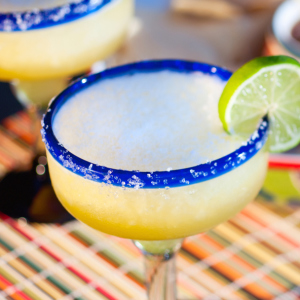Royally claiming the crown as one of the most popular drinks in the world, the Margarita is a classic worthy of praise. While its basic template of tequila, orange liqueur and lime juice calls for simplicity, it is open to suggestion and has played the role as the foundation to many complex concoctions.
 Clearly defining the “Perfect Margarita” is not an easy feat, as this cocktail-martini hybrid has such an acquired taste. The phrase means something different to everyone, which is a beautiful thing. One of the great qualities of the Margarita is that it can be so fun to experiment with. Sometimes, though, simple is better. In its purest form, the Margarita is a wonderful drink that really doesn’t need to be tinkered with.
Clearly defining the “Perfect Margarita” is not an easy feat, as this cocktail-martini hybrid has such an acquired taste. The phrase means something different to everyone, which is a beautiful thing. One of the great qualities of the Margarita is that it can be so fun to experiment with. Sometimes, though, simple is better. In its purest form, the Margarita is a wonderful drink that really doesn’t need to be tinkered with.
While the definition of a perfect margarita can be argued, we believe it’s best to give credit to the traditional three-part combo that has kept the Margarita on its throne – tequila, orange liqueur and lime juice. The importance of using quality ingredients is key to making any drink a great one. The cheapest bottle probably won’t result in an outstanding drink, but many mid-priced spirits are quite competent.
Here are some guidelines to creating the basis for a perfect margarita.
Tequila
The spirit and the backbone of the Margarita. For ideal results, it’s best to choose 100% blue agave tequila. Look for the “100% (puro) de agave” label on your bottle to ensure you’re working with the highest quality tequila.
Should you use blanco (also known as “white” or “platinum”), reposado or añejo? Blanco is most commonly used to make margaritas, but the following two options work as well. They tend to have a smoother, mellower flavor that some prefer. It all comes down to which taste you prefer through your own exploration.
Orange Liqueur
The sweetener. Triple Sec, Grand Marnier or Cointreau are commonly used as the second key ingredient in a margarita. Triple Sec is lower in alcohol content than the following two options, which also have a more distinct flavor. Cointreau has a light base and flavor while Grand Mariner is a dark based orange liqueur. The common element is their orange flavor.
Here is a short history of orange liqueurs.
Lime Juice
The souring agent, and the only non-alcoholic ingredient in the Margarita. There really is no substitute that comes close to freshly-squeezed limes. While it may take more time and energy to choose ripe limes over a pre-mixed lime juice, it’s worth it in the end result. The Lime is a crucial component to making a margarita that’s striving towards perfection. If you do choose a pre-made lime juice, taste it before you mix it with your other ingredients to be sure it’s a pleasant taste in your mouth.
By building a solid foundation using the above three ingredients, you can begin to explore how other fresh fruits and vegetables – like lemons, peaches, berries, cucumber or mint – can jazz it up. Frozen or on the rocks, you can garnish your finished margarita with a lime or orange slice and a sugar- or salt-dipped rim, if you so choose.
There are as many margarita variations as there are taste buds around the world. The best way to discover the perfect margarita for you is to taste test the drink in all its variations (as well as its classic form!). Here at Casa Blanca Mexican Restaurants we cherish the simple and complex, with tropical and specialty margaritas to satisfy every craving. We even have an Avocado Margarita recipe for you! View our drink and desserts menu at our our Andover restaurant and our North Andover restaurant.
As a testament to its greatness, the Margarita has stood up to the test of time and experimentation. An elegant classic to behold, for sure.

